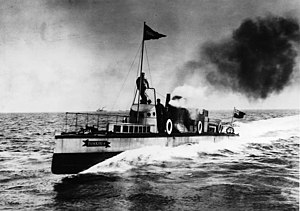Turbinia

Turbinia at speed in 1897
|
|
| History | |
|---|---|
|
|
|
| Name: | Turbinia |
| Launched: | 2 August 1894 |
| Out of service: | 1927 |
| Refit: | 1960s |
| Nickname(s): | "The Ocean Greyhound" |
| Status: | Museum ship |
| General characteristics | |
| Displacement: | 44.5 tons |
| Length: | 104 ft 9 in (31.93 m) |
| Beam: | 9 ft (2.7 m) |
| Draught: | 3 ft (0.91 m) |
| Propulsion: |
|
| Speed: | 34.5 kn (63.9 km/h; 39.7 mph) |
Turbinia was the first steam turbine-powered steamship. Built as an experimental vessel in 1894, and easily the fastest ship in the world at that time, Turbinia was demonstrated dramatically at the Spithead Navy Review in 1897 and set the standard for the next generation of steamships, the majority of which were turbine powered. The vessel can still be seen at the Discovery Museum in Newcastle upon Tyne, North East England, while her original powerplant can be found at the London Science Museum.
Charles Algernon Parsons invented the modern steam turbine in 1884, and, having foreseen its potential to power ships, he set up the Parsons Marine Steam Turbine Company with five associates in 1893. To develop this he had the experimental vessel Turbinia built in a light design of steel by the firm of Brown and Hood, based at Wallsend on Tyne in the Northeast of England.
The Admiralty was kept informed of developments, and Turbinia was launched on 2 August 1894. Despite the success of the turbine engine, initial trials with one propeller were disappointing. After discovering the problem of cavitation and constructing the first cavitation tunnel, Parsons' research led to him fitting three axial-flow turbines to three shafts, each shaft in turn driving three propellers, giving a total of nine propellers. In trials this achieved a top speed of over 34 knots (63 km/h), so that "the passengers aboard would be convinced beyond all doubt Turbinia was Charles Parsons' winning North Sea greyhound".
The turbines were directly driven, as geared turbines were not introduced until 1910. Even after the introduction of geared turbines, efficiency of even the largest axial steam turbines was still below 12 percent. Turbinia was even less efficient, with its direct drive turbine moving with a tip speed of just 30 meters per second. Despite this, it was a dramatic improvement over predecessors.
...
Wikipedia
